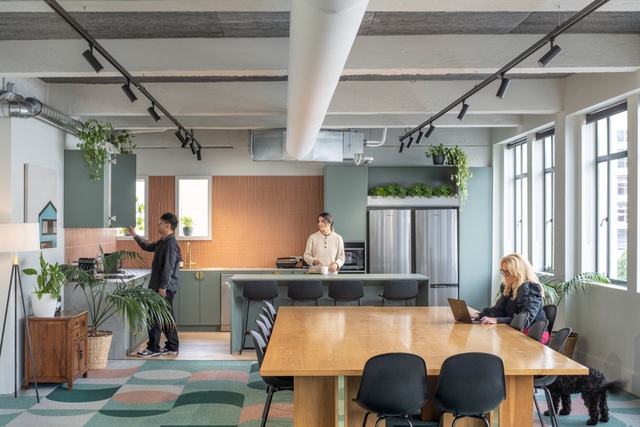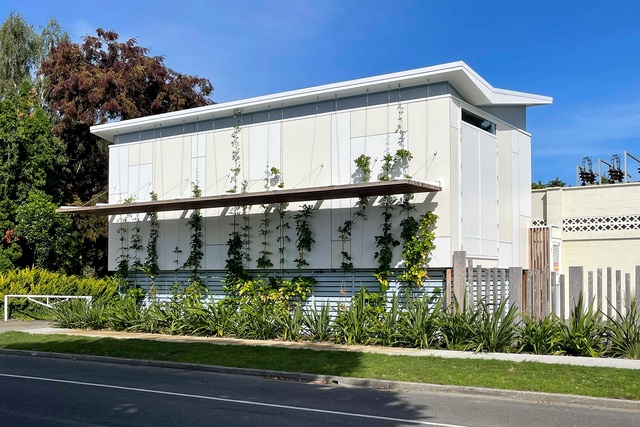Architecture for Resilient Communities in Aotearoa
World Architecture Day is an opportunity to consider our urban communities and built environments. How do we make them more resilient? Less taxing on the planet? More socially cohesive and able to cope with population pressures?
For World Architecture Day 2023, The Te Kāhui Whaihanga NZIA reached out to two architects leading the way in improving resilience in built environments in their practices, and an academic focussed on the holistic architectural design of future environments, for their take on this year’s World Architecture Day theme: Architecture for Resilient Communities.
James Solari, Solari Architects
“Architectural resilience is physical, social and seismic,” says Te Whanganui-a-Tara Wellington architect James Solari. “Architecture has a huge part to play in our urban communities. Our built environment is a fundamental enabler for the way not only people, but society as a whole interacts.”

In the Capital, where seismic risk and resilience is an ongoing challenge, Solari’s own Cuba Street studio is a great example of seismic resilience. It sat vacant for many years because it wasn’t up to seismic code, but was eventually sold to a new owner and strengthened up to 90%. Working in the building has inspired Solari Architects to take on neighbouring heritage buildings and improve their resilience. “The older Cuba character buildings are what we’re focussed on,” Solari says. “We can help commercial owners to invest in that asset in a good way and ensure a future. It is not just a matter of undertaking minimum strengthening, but creating new opportunities by designing a functional and desirable outcome with the best seismic upgrade the building can afford. This is the heart and soul of the city and it needs good investment to build its resilience.”
Solari says that while people are resilient, our built environment and infrastructure have proven not to be in light of climate change. “We need to learn from this and do better,” he says. “Managed retreat and moving people and buyouts are options to be considered, but it’s not just the house, it’s the community. Understanding those human aspects of community, a sense of belonging, you can’t just always move people on.” It’s why, in multi-residential developments in Karori Road in Wellington and Riverside Drive in Lower Hutt, Solari has built in climate change resilience strategies, including raising floor levels and locating garages on lower levels so they are more flood resilient. Residents may have to move out in extreme weather events, but can get back in quicker and with minimal reconstruction and disruption.
“We need to learn from this and do better. Managed retreat and moving people and buyouts are options to be considered, but it’s not just the house, it’s the community. Understanding those human aspects of community, a sense of belonging, you can’t just always move people on.”
-James Solari
In his Kainga Ora Mount Cook development, where 80 apartments are nearing completion, social resilience is built into the architecture. “It is Wellington’s first example of single site supported living,” explains Solari. “Wellington City Mission will provide 24/7 onsite support; there are dedicated rooms and support spaces for pastoral care. There are communal veggie growing areas, and a community hall for the whole neighbourhood. These are places for people to connect and interact.”
Bringing in a te ao Māori viewpoint of land and environment adds another layer to architecture, Solari says. “Treating land and the environment and water as important is a different lens. Thinking about how you create community amongst that is really important. We are short term occupants and to ensure we leave it in a better place for our future generations, we need to enjoy how we use it. There’s always a connection to the back story of what a site means and how that story can be told going forward. We’ve got so much we can contribute to that as architects. Fostering a connection and community, amongst each other and supporting each other, is a great way to inform how we can live better.”
Charissa Snijders, Architect
“If you take the premise that there is no community resilience without ecological resilience, then our industry’s impact is enormous,” says Charissa Snijders. “Intensification is also a huge impact on our ecology; an impact too enormous for us to ignore. We can intensify but we need to do it differently, with sponge cities, nested projects, and by understanding heat sinks. Our responsibility as architects is critical and we need to facilitate transformational change.”

Snijders is a member of the global Regenesis group of practitioners that are committed to regenerative development. This goes beyond creating sustainable architecture, to changing the architectural process to start with a deeper connection with clients and the place, to listen to what is needed to make the built environment and its surroundings regenerative. Engineers, ecologists and sustainability experts are consulted.
“You have to understand the ecological zone you are in and next to, so the boundary of the site becomes an imaginary line. You understand how it nests in the community. What was there historically — culturally, geologically, etc. — is important,” the Tāmaki Makaurau architect explains.
“I’m worried that the urgency of collective change required in our industry is not happening fast enough. We need to shift from short-term gain to a seventh generation perspective. Architects can lead the way on this and claim the space.”
-Charissa Snijders
It’s a philosophy applied to a Unison Substation in Hawkes Bay. In September, the building designed by Snijders became the first landscape and infrastructure project in the world to receive Living Building Challenge Vs 4.0 Petal Certification through the International Living Future Institute. It was also the winner of the Low Carbon Future Award at the New Zealand Energy Excellence Awards last year.
“This living building is a great recognition of a moment,” says Snijders. “But I’m worried that the urgency of collective change required in our industry is not happening fast enough. We need to shift from short-term gain to a seventh generation perspective. Architects can lead the way on this and claim the space. We have been trained to take complex ideas and understand them, understand the whole. We’re ideal to hold that space.”
Dr Maibritt Pedersen Zari
In July, Maibritt Pedersen Zari took part in the UIA World Congress of Architects in Copenhagen, Denmark, the largest architecture event in the world, as co-chair of the climate change adaptation research section.

“A purely technical approach to climate change isn’t going to work,” says the associate professor at the School of Future Environments, Te Wānanga Aronui O Tāmaki Makau Rau Auckland University of Technology. “Architects, can’t solve all the problems, but they need to conceive of buildings becoming green spaces themselves. We can’t just rely on urban green and blue spaces to do all the ecological things we need to stay functional, because our cities are becoming more dense and population is increasing. Built infrastructure itself, including buildings has to be able to be ecologically functional. Strategically adding vegetation onto or into buildings is one way to do this.”
In an article titled Regenerative living cities and the urban climate–biodiversity–wellbeing nexus, Pedersen Zari and her colleagues M. MacKinnon, K. Varshney and N. Bakshi explain that “Urban expansion contributes substantially to global habitat loss, fragmentation and degradation through land-use and land-cover change, and pollution arising from the construction and operation of cities.”
“For architects, effectively contributing to community resiliency practices means recognising that colonisation and the social structures it perpetuates, continues to play a role in reducing the resiliency of communities.”
- Dr Maibritt Pedersen Zari
In the article, Pedersen Zari and her co-writers cite the following statistics: green roofs can provide energy savings of up to 85% for cooling and 48% for heating, and green walls have shown savings of up to 66% for cooling, depending on the climate and construction type. A decrease in external wall surface temperature of up to 11°C was measured after the installation of a green wall in Athens, Greece and a hydrological modelling study of Curico, Chile, found that installing green roofs across at least 50% of the study area could prevent flooding from moderate rainfall events, with 60–96% coverage required for strong rainfall events.
Nature-based architecture has an impact on human wellbeing and resilience too, with green spaces leading to stress reduction, psychological restoration and improved mood.
There are also cultural and political issues that need to be addressed: Decolonising architecture makes it more resilient, Pedersen Zari says, and goes beyond structural resiliency into the social resilience of communities. Here, that means a focus on “embedding tikanga Māori practices (correct / appropriate cultural or customary practices) to place community needs at the forefront” Pedersen Zari writes, with co-authors P. McAleer-Harding; M. Abbott and R. Kiddle, in Decolonising Resilient Architecture.
“For architects, effectively contributing to community resiliency practices means recognising that colonisation and the social structures it perpetuates, continues to play a role in reducing the resiliency of communities.”
Re-published from the original article posted 02 October 2023 on www.nzia.co.nz









